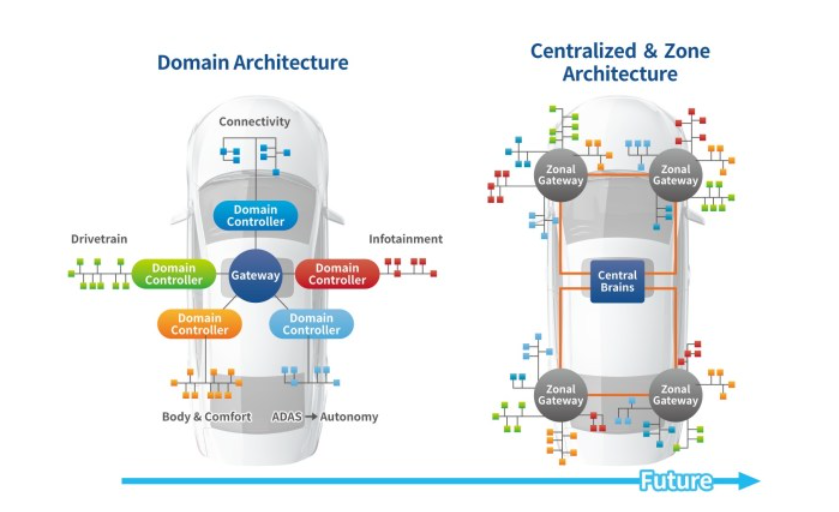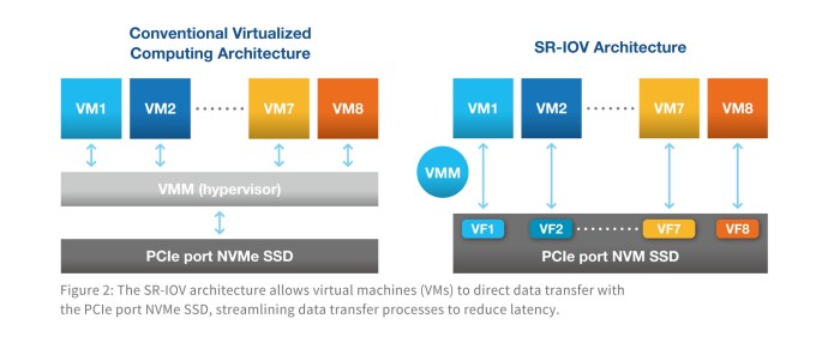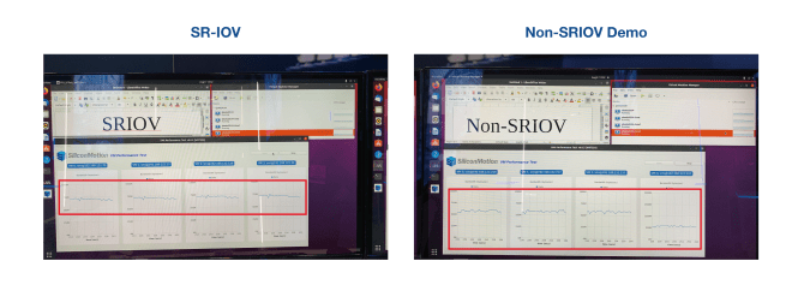 0
0








 0
0









The latest zonal architecture promises to simplify vehicle electrical infrastructures, potentially saving weight and complexity while enhancing reliability, safety, and security. As this new approach is adopted, software-based virtual machines with hardware-based I/O Virtualization are needed to manage resources and ensure isolation.
Introduction: Transforming the Automotive Architecture
As modern vehicles rely increasingly on electronically controlled and software-defined functions, the typical domain-based electrical architecture that dedicates a control unit for each is giving way to a zonal approach. The domain approach, which groups functions by domain such as powertrain, chassis, and infotainment, has driven a rapid increase in the number of ECUs on board the vehicle as well as increased wiring complexity. The zonal approach, where ECUs are classified according to their location in the vehicle, contains a centralized communication gateway and compute module sized to handle workloads from multiple ECUs within the vehicle. It gives the opportunity to reduce the number of ECUs and simplify the wiring, permitting space savings and reduced vehicle weight.

In addition, as vehicles become more complex with the introduction of advanced features and connectivity, zone-based architectures can scale more easily by adding or modifying zones. Further advantages include the potential to ease system integration by grouping related functions and components together, which reduces complexity during development, as well as the chance to improve fault isolation and improve safety and security by compartmentalizing functions into zones.
While transitioning to the zone-based architecture to get savings and improvements, it is important to retain some attributes that have been present in the preceding approaches such as the domain-based architecture. Some critical functions, like safety-critical systems (e.g., ABS, airbags), benefit from being isolated within their domains and can permit enhanced safety by reducing the risk of interference from other non-critical functions.

It is also worth noting that domain-based architectures allow for specialized development teams for each domain (e.g., powertrain, infotainment). These teams can focus on optimizing their specific functions, leading to potentially higher performance and efficiency within their respective domains.
Zonal architecture adoption is anticipated to accelerate the trend towards software-defined vehicles as zonal gateways and the central compute cluster can be easily updated with software to improve functionality or add new features. Moreover, the zonal gateway facilitates the integration of powerful edge computing to ensure the vehicle handle critical events that require fast response.
The Need for Virtualization
In a zone-based architecture, virtual machines (VMs) can play a crucial role by offering isolation, resource control, flexibility, and security. They are a valuable tool for designing and managing complex systems with multiple functional zones.
Isolation is achieved by running each functional zone on a separate VM. This way, any zone experiencing a failure or security breach is less likely to impact other zones, which enhances overall system reliability and security. In addition, VMs allow computing resources such as CPU cycles, RAM, and storage to be precisely allocated to each zone. This enables critical zones to receive the necessary resources, while contentions that can lead to performance issues are avoided.
Also, using VMs allows separation between software stacks for different zones, permitting each VM to have its own operating system and software dependencies. Compatibility issues and conflicts between zones can be reduced.
In addition, security policies and access controls can be configured to allow fine-grained security management within each zone and thus strengthen security for sensitive data and functions.
During development, engineers can work on individual zones within separate VMs, allowing for isolated testing and debugging. This minimizes the risk of changes in one zone affecting others. on the other hand, VMs can be easily duplicated or scaled to accommodate changing requirements within a particular zone.
Making VMs Work with I/O Virtualization
In an automotive electrical infrastructure, various functions and components run on different virtual machines (VMs) to isolate their software stacks. These VMs are used for specific tasks, such as powertrain control, infotainment, or advanced driver assistance systems (ADAS). Where this is the case, I/O virtualization is an effective technique that enables the VMs to interact efficiently and securely with physical I/O devices like sensors, actuators, and storage.
For implementing virtualization, the SR-IOV (Single-Root IO Virtualization) delivers several advantages. It includes enhanced system reliability and security, by providing strong isolation between virtual functions and the physical device to prevent conflicts, ensuring that each VM can access the necessary hardware without contention. Also, by providing a standardized framework for configuring and monitoring virtualized I/O devices, SR-IOV can simplify the management of I/O resources.

The key advantage of SR-IOV, as depicted in Figure 2, allows data to bypass the hypervisor layer, enabling direct data transfer between the virtual machines (VMs) and the PCIe port NVMe SSD. This direct path significantly reduces latency by eliminating the data allocation between PCIe and host, and it also lessens the computational load on the CPU that hosts the hypervisor.
In addition, multiple VMs or partitions can share a single physical I/O device, thereby ensuring efficient resource utilization that reduces the number of dedicated hardware components needed. This can be especially valuable in space-constrained automotive environments.
In applications where real-time processing of data from sensors and actuators is required, VMs aided by I/O virtualization can access hardware interfaces directly and efficiently, reducing latency and overhead. As more and more vehicles rely on advanced driver assistance systems (ADAS) and autonomous driving, for improved safety, virtualization is effective to ensure timely responses to critical events.
I/O virtualization also contributes to fault isolation and recovery. If a VM fails, the function-level reset (FLR) command can reset and reconnect the VM with the SSD without impacting other VMs and virtual functions. This enhances system reliability of automotive systems and is extremely important for safety-critical applications.
Finally, using VMs with I/O virtualization can strengthen security and enhance scalability. Each VM can be configured with specific security measures including access controls and policies tailored to its function, preventing unauthorized access to I/O resources. Scalability is ensured by allowing additional VMs or partitions to be added without major changes to the underlying hardware.
As the industry moves towards zonal automotive architectures, seeking efficiency gains and bill-of-materials savings, combining VMs with I/O virtualization ensures efficient, scalable, and reliable systems. VMs help compartmentalize functions, while I/O virtualization enables the VMs to interact with physical I/O devices, ensuring isolation, real-time performance, and security.
The advantages of SR-IOV architectures for the evolving needs of the automotive market include:
Efficiency and Low latency:
SR-IOV ensures near-native response times, leading to highly efficient and stable systems. In automotive applications where even millisecond delays matter, this can be crucial. In addition, reduced CPU Usage allows data to bypass the hypervisor and go directly to the application. This allows for more CPU resources to be available for other tasks, thereby improving the efficiency of the system.
Scalability:
By providing multi-namespace support, SR-IOV permits efficient sharing of I/O resources among multiple applications or virtual machines. This is invaluable in automotive contexts that necessitate the simultaneous operation of several services, such as navigation, infotainment, and driver-assistance systems.
SR-IOV ensures seamless communication, enabling information sharing among different Virtual Functions (VFs) thereby bolstering the collaborative capabilities of various automotive systems.
Reliability:
Isolation is ensured. The function-level reset (FLR) interface can reset the individual SR-IOV functions This ensures that, when a VM fails, it can be reset and using FLR to reconnect with the SSD without impacting other VMs and VFs.
In the automotive context, this ensures that critical systems are isolated from non-critical systems, reducing the risk of system-wide failures and enhancing the reliability and security of each application running on the hardware.

Future-proofing:
As automotive systems continue to evolve, SR-IOV provides a robust architecture tailored to integrate new technologies seamlessly. Its ability to allocate Virtual Functions (VFs) to support Virtual Machines (VMs) directly reduces latency significantly. SR-IOV thus ensures low latency and high throughput, which meets the critical requirements for real-time data processing in autonomous driving vehicles.
Cost-Efficiency:
SR-IOV facilitates resource optimization by reducing CPU usage and aiding efficient use of I/O. This can significantly reduce the total cost of ownership (TCO) for automotive companies.
Lower CPU usage also means less energy consumption, which is a critical factor in battery-operated electric vehicles.
Simplified Management:
SR-IOV requires less complex configuration and management compared to traditional I/O virtualization methods, making it easier to deploy and maintain.
From performance gains and reduced CPU usage to better scalability and futureproofing, SR-IOV presents a strong case for being the go-to architecture for next-generation automotive systems.
Automotive PCIe Gen4 SSD Controllers Live Demonstration Results
Silicon Motion Introduced and demoed the SM2264XT-AT at the Flash Memory Summit. The SM2264XT-AT SSD controller with SR-IOV showcased unmatched SSD performance, seamless VM management, boosted speed, and reduced CPU load.

A side-by-side demonstration comparing SR-IOV and Non-SR-IOV configurations on two separate PCs revealed significant advantages for SR-IOV.
This demonstration underscores SR-IOV as a more reliable and robust solution, ready for immediate implementation and offering immediate benefits. From performance gains and reduced CPU usage to better scalability and future-proofing, SR-IOV presents a compelling case for being the architecture of choice for next-generation automotive systems.
Summary
The surge in data transmission and computational needs within automotive systems is driving a transformative shift in vehicle architecture. As vehicles become more reliant on electronic control and software, there’s an uptick in the demand for controllers and a challenge to manage the complexity and bulk of wiring. The new zonal approach can simplify the vehicle architecture as the number of functions continues to increase. With automakers and Tier 1 suppliers increasingly adopting SoCs that accommodate the PCIe interface, the future system requirements align closely with the existing PCIe NVMe SSDs as well. This trend indicates that PCIe SSDs in the automotive industry will be more widely implemented in the next few years.
About US
Heisener Electronic is a famous international One Stop Purchasing Service Provider of Electronic Components. Based on the concept of Customer-orientation and Innovation, a good process control system, professional management team, advanced inventory management technology, we can provide one-stop electronic component supporting services that Heisener is the preferred partner for all the enterprises and research institutions.
